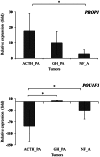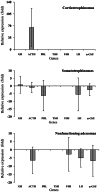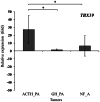PROP1 overexpression in corticotrophinomas: evidence for the role of PROP1 in the maintenance of cells committed to corticotrophic differentiation
- PMID: 23778486
- PMCID: PMC3674306
- DOI: 10.6061/clinics/2013(06)26
PROP1 overexpression in corticotrophinomas: evidence for the role of PROP1 in the maintenance of cells committed to corticotrophic differentiation
Abstract
Objective: The expression of transcription factors involved in early pituitary development, such as PROP1 and POU1F1, has been detected in pituitary adenoma tissues. In this study, we sought to characterize the transcriptional profiles of PROP1, POU1F1, and TBX19 in functioning and nonfunctioning pituitary adenomas in an attempt to identify their roles in tumorigenesis and hormone hypersecretion.
Methods: RT-qPCR analyses were performed to assess the transcriptional pattern of PROP1, POU1F1, TBX19, and hormone-producing genes in tissue samples of corticotrophinomas (n=10), somatotrophinomas (n=8), and nonfunctioning adenomas (n=6).
Results: Compared with normal pituitary tissue, POU1F1 was overexpressed in somatotrophinomas by 3-fold. PROP1 expression was 18-fold higher in corticotrophinomas, 10-fold higher in somatotrophinomas, and 3-fold higher in nonfunctioning adenomas. TBX19 expression was 27-fold higher in corticotrophinomas. Additionally, the level of TBX19 mRNA positively correlated with that of pro-opiomelanocortin (r=0.49, p=0.014).
Conclusions: Our data demonstrate that PROP1 is overexpressed in pituitary adenomas, mainly in corticotrophinomas. Together with previously published data showing that patients who harbor PROP1 loss-of-function mutations present a progressive decline in corticotrope function, our results support a role for PROP1 in pituitary tumor development and in the maintenance of cell lineages committed to corticotrophic differentiation.
Conflict of interest statement
No potential conflict of interest was reported.
Figures



Similar articles
-
Prop-1 gene expression in human pituitary tumors.J Clin Endocrinol Metab. 1999 Jul;84(7):2581-4. doi: 10.1210/jcem.84.7.5974. J Clin Endocrinol Metab. 1999. PMID: 10404841
-
The Complementary Role of Transcription Factors in the Accurate Diagnosis of Clinically Nonfunctioning Pituitary Adenomas.Endocr Pathol. 2015 Dec;26(4):349-55. doi: 10.1007/s12022-015-9398-z. Endocr Pathol. 2015. PMID: 26481628
-
Multihormonal pituitary adenoma concomitant with Pit-1 and Tpit lineage cells causing acromegaly associated with subclinical Cushing's disease: a case report.BMC Endocr Disord. 2017 Sep 2;17(1):54. doi: 10.1186/s12902-017-0203-5. BMC Endocr Disord. 2017. PMID: 28865461 Free PMC article.
-
Gene and protein expression in pituitary corticotroph adenomas: a systematic review of the literature.Neurosurg Focus. 2015 Feb;38(2):E17. doi: 10.3171/2014.10.FOCUS14683. Neurosurg Focus. 2015. PMID: 25639319 Review.
-
Pituitary transcription factors: from congenital deficiencies to gene therapy.J Neuroendocrinol. 2006 Sep;18(9):633-42. doi: 10.1111/j.1365-2826.2006.01461.x. J Neuroendocrinol. 2006. PMID: 16879162 Review.
Cited by
-
Identification of differentially expressed genes in pituitary adenomas by integrating analysis of microarray data.Int J Endocrinol. 2015;2015:164087. doi: 10.1155/2015/164087. Epub 2015 Jan 6. Int J Endocrinol. 2015. PMID: 25642247 Free PMC article.
-
Genetic Approaches to Hypothalamic-Pituitary-Adrenal Axis Regulation.Neuropsychopharmacology. 2016 Jan;41(1):245-60. doi: 10.1038/npp.2015.215. Epub 2015 Jul 20. Neuropsychopharmacology. 2016. PMID: 26189452 Free PMC article. Review.
-
Visfatin (NAMPT) affects global gene expression in porcine anterior pituitary cells during the mid-luteal phase of the oestrous cycle.J Anim Sci Biotechnol. 2024 Jul 9;15(1):96. doi: 10.1186/s40104-024-01054-z. J Anim Sci Biotechnol. 2024. PMID: 38978053 Free PMC article.
-
Novel Nucleotide Variations, Haplotypes Structure and Associations with Growth Related Traits of Goat AT Motif-Binding Factor (ATBF1) Gene.Asian-Australas J Anim Sci. 2015 Oct;28(10):1394-406. doi: 10.5713/ajas.14.0860. Asian-Australas J Anim Sci. 2015. PMID: 26323396 Free PMC article.
References
-
- Nakamura S, Ohtsuru A, Takamura N, Kitange G, Tokunaga Y, Yasunaga A, et al. Prop-1 gene expression in human pituitary tumors. J Clin Endocrinol Metab. 1999;84:2581–4. - PubMed
-
- Evans CO, Moreno CS, Zhan X, McCabe MT, Vertino PM, Desiderio DM, et al. Molecular pathogenesis of human prolactinomas identified by gene expression profiling, RT-qPCR, and proteomic analyses. Pituitary. 2008;11(3):231–45. - PubMed
-
- Moreno CS, Evans CO, Zhan X, Okor M, Desiderio DM, Oyesiku NM. Novel molecular signaling and classification of human clinically nonfunctional pituitary adenomas identified by gene expression profiling and proteomic analyses. Cancer Res. 2005;65(22):10214–22. - PubMed
-
- Evans CO, Young AN, Brown MR, Brat DJ, Parks JS, Neish AS, et al. Novel patterns of gene expression in pituitary adenomas identified by complementary deoxyribonucleic acid microarrays and quantitative reverse transcription-polymerase chain reaction. J Clin Endocrinol Metab. 2001;86(7):3097–107. - PubMed
Publication types
MeSH terms
Substances
LinkOut - more resources
Full Text Sources
Other Literature Sources

